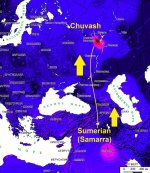Alan
Elite member
- Messages
- 2,517
- Reaction score
- 450
- Points
- 0
- Ethnic group
- Kurdish
- Y-DNA haplogroup
- R1a1a1
- mtDNA haplogroup
- HV2a1 +G13708A
In the past I wrote that my maternal Haplogroupn is most likely of Scythian origin, a strong evidence for this is that Haplogroup HV2 was found among two Scythian Ice mummies in the Altais so far and nowhere else.
Another reasonable argument is that this Haplogroup is quite young (few thousand years).
Than I thought to take a look at the ftDNA database and where it is found.
According to ftDNA it is very rare and only found in 2-4 individuals in their database so far.
https://www.familytreedna.com/public/mtdna_hv/default.aspx?section=mtmap
One of them from Chuvashia in Russia. Chuvash are believed to be related to the Volga Bulgars and therefore might be mostly of native Scythian stock who have absorbed some East Eurasian admixture and became Turkic speakers.
Another one is found in the city of Saqqez in Eastern Kurdistan (West Iran). So the question came up what does Saqqez have to do with Scythians.
Here is the answer.
I think it is obvious that the distribution of this rare Haplogroup overlaps well with the expansion of Scythians.
Another reasonable argument is that this Haplogroup is quite young (few thousand years).
Than I thought to take a look at the ftDNA database and where it is found.
According to ftDNA it is very rare and only found in 2-4 individuals in their database so far.
https://www.familytreedna.com/public/mtdna_hv/default.aspx?section=mtmap
One of them from Chuvashia in Russia. Chuvash are believed to be related to the Volga Bulgars and therefore might be mostly of native Scythian stock who have absorbed some East Eurasian admixture and became Turkic speakers.
Another one is found in the city of Saqqez in Eastern Kurdistan (West Iran). So the question came up what does Saqqez have to do with Scythians.
Here is the answer.
Saqqez (Kurdish: Seqiz, Persian: سقز; also known as Saghez, Saqqiz, and Sakīz)[1] is a city in and capital of Saqqez County, Kurdistan Province, Iran. At the 2011 census, its population was 139,738.
The Kurds and their ancient Iranian ancestors have lived in Seqiz and the surrounding areas since approximately 1000 B.C. By the mid-seventh century B.C., the Scythians under Bartatua reached the summit of their might in western Asia, and the region of Saqqez was their political center.[2] In the pre-Islamic era, Seqiz and the surrounding areas comprised a small country known as Sagapeni, which is believed to be related to the name of the ancient Iranian Sakas (Scythians) from which the name of the city is derived.
I think it is obvious that the distribution of this rare Haplogroup overlaps well with the expansion of Scythians.
Last edited:


